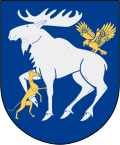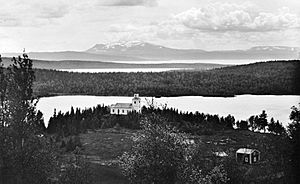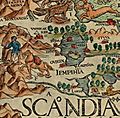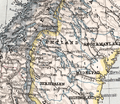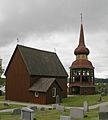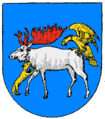Jämtland facts for kids
Quick facts for kids
Jämtland
|
||
|---|---|---|
|
||
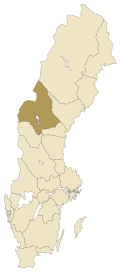 |
||
| Country | Sweden | |
| Land | Norrland | |
| Counties | Jämtland County Västernorrland County Västerbotten County |
|
| Area | ||
| • Total | 34,009 km2 (13,131 sq mi) | |
| Population
(2009)
|
||
| • Total | 112,717 | |
| • Density | 3.31433/km2 (8.58407/sq mi) | |
| Ethnicity | ||
| • Language | Swedish | |
| • Dialect | Jamtlandic | |
| Culture | ||
| • Flower | Orchid | |
| • Animal | Moose | |
| • Bird | Hawk owl | |
| • Fish | Brown trout | |
| Time zone | UTC+1 (CET) | |
| • Summer (DST) | UTC+2 (CEST) | |
Jämtland is a historical province located in the middle of Sweden. It's in northern Europe. Jämtland shares borders with Härjedalen and Medelpad to the south. To the east is Ångermanland, and to the north is Lapland. To the west, it borders Trøndelag and Norway.
Jämtland is a large area, covering 34,009 square kilometres. This makes it the second biggest province in Sweden. It takes up about 8.3% of Sweden's total land. Around 115,331 people live here. Most of them live near the big lake called Storsjön. The only city in Jämtland is Östersund. It is the 24th most populated city in Sweden.
Long ago, Jämtland was a self-governing area. It was like its own small country with its own rules and money. It even had its own parliament. However, it didn't have a strong government system. In 1178, Norway took control of Jämtland. It remained Norwegian for over 450 years. Then, in 1645, it became part of Sweden. Jämtland has been Swedish for about 370 years. But the people living there didn't become Swedish citizens until 1699.
The current King of Sweden, Carl XVI Gustaf, was given the title Duke of Jämtland when he was a baby. He kept this title until he became king in 1973. Jämtland has a special history because it was often caught between Norway and Sweden. This is shown in its coat of arms. The silver moose in the middle is threatened from both the east and the west. During a time of conflict (1563–1677), Jämtland changed sides 13 times!
History of Jämtland
Scientists have found very old things in Jämtland. These include parts of a woolly mammoth in Pilgrimstad. This shows that giant animals lived here long before humans.
The first humans arrived in Jämtland about 7,000 to 6,000 years before Christ. They came from the west, crossing the Scandinavian Mountains. At that time, the weather was much warmer than it is today. Trees like oak grew high up on what are now mountains. Thousands of old sites have been found. Most of these are near ancient campsites, beaches, and lakes.
The oldest known settlement is at Foskvattnet. This place is near where the ancient Fosna culture lived. This settlement dates back to 6600 BC. In Jämtland, the moose was the most hunted animal. This is clear from the many petroglyphs (rock carvings) and rock paintings found. Jämtland has over 20,000 recorded ancient monuments. The oldest is an arrowhead found in Åflo near Kaxås. It might be over 8,000 years old. This would make it one of the oldest Stone Age finds in all of Sweden.
Rock paintings in Jämtland are often found near trapping pits. More than 10,000 pits used for hunting have been found here. This is far more than in any other part of Scandinavia. These pits were dug in places where animals were known to travel. Sometimes, pits were dug in long lines stretching for miles. Many local place names in Jämtland still show how important these pits were to the early tribes.
A new way of life, called the Neolithic culture, started in Jämtland during the late Roman Iron Age. This was when people began to settle down and farm. Before this, people were mostly hunter-gatherers. But they had learned about farming from others. Hunting was very good in Jämtland, so it took a long time for people to change their ways.
The change to farming happened quickly once it started. People from Trønder had been farmers for a long time. Some people in Jämtland had already started herding animals. The farmers in Jämtland mainly grew barley. Studies of plant pollen also show they grew hemp. Around the end of the 4th century, a fortress called Mjälleborgen was built on Frösön. This fortress helped control the making and trade of iron. There was a lot of influence from the west, from Trøndelag, through Jämtland to Norrland.
During the Viking Age, more people settled in Jämtland. The climate became warmer, which helped agriculture grow. This period is known as the Medieval Warm Period. Animal farming and a special way of moving livestock, called buföring, became more common. This was especially true in southern Jämtland, where a type of cow called the "fell cow" was introduced. Hunting for moose and other wild animals also increased.
The people of Jämtland, called Jamts, changed their religion. They stopped following the old Germanic tribal religion. Instead, they became Christians. In their old religion, they mostly worshipped the Vanir gods. These included Freyr, Njord, and Ullr. But they also worshipped the Æsir gods.
Jämtland's Unique Culture
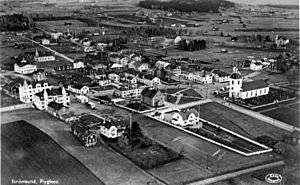
The culture of Jämtland is special. This is because Jämtland never had a strong upper class. Most people were free farmers who owned their land. They had many connections and a strong sense of who they were. This has been true for many generations. Jämtland started as a free area. It stayed independent even when it was controlled by Norway. Because of this history, the local culture is very similar to the Norwegian farm culture.
Today, you can learn about Jämtland's history at the regional museum called Jamtli. It is in Östersund. The museum has an outdoor section with old buildings. It also has an indoor museum. This part shows exhibitions about the region's culture. You can see things from the Stone Age up to modern times. Learning about local history has been popular in Jämtland for over 100 years. This is thanks to a strong cultural movement that started in the late 1800s and early 1900s. This movement created Jamtli to protect the region's cultural heritage.
Images for kids
-
Jämtland means "Jamts' land." Here, the Viking Arnljot Gelline from Jämtland travels through the landscape.
-
A part of Olaus Magnus’ Carta Marina (1539). Jämtland is called "Iempihia" in Latin.
-
Jämtland – the land in between (mitt emellom). It's only a few kilometers to the Bothnian Sea and the Norwegian Sea. This is why Jämtland was often taken over by other countries. This map from 1905 shows the Jämtland County at that time, which included Jämtland and Härjedalen.
-
Östersund, the winter city.
-
The old church in Håsjö. Churches were usually built in central places where everyone could see them. A copy of this bell tower, which is typical for Jämtland, is at Skansen in Stockholm.
-
The Neoclassical and Gothic-style church in Bräcke. It was built by the local people in the 19th century.
-
A Sami goahti (traditional tent) in Arådalen.
-
The mountains in Scandinavia are called fells. This picture shows Storsjön, "the Great Lake," and distant fells.
-
The freeskiing competition Jon Olsson invitational in Åre.
-
Traditional summer houses, buvåll "critter house" in Jämtland. 'Bu' is like the English word "booth" and 'våll' is like "weald".
See also
 In Spanish: Jämtland para niños
In Spanish: Jämtland para niños


